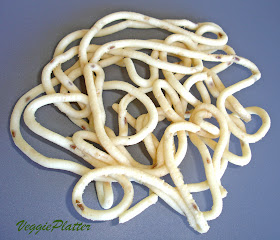
Here is a simple, protein rich snack great for munching.
Usually I buy fried dals when ever I go shopping for Indian groceries since my kids' seem to love them. This time, I tried frying moong dal (in oil) at home for the first time. I had heard my MIL 's recipe from my husband and so followed those instructions. It is quite a simple preparation.
I also tossed a batch of dal coated with oil in the MW to see how they turn out. I was a little skeptical about frying moong dal in the MW because I was expecting the dal to get burnt. I did it anyway and to my surprise, the experiment was a success.
Both the versions tasted identical. The MW method takes a bit longer compared to the oil fry method and (very slightly), the dal may not be uniform in color.
Oil fry method:
Ingredients:
Moong dal - 1 Cup
Baking soda - 1 tsp
Oil to fry - 1 to 1.5 cups
Salt
Method:
Wash the moong dal in water once or twice and throw away the water used.
Soak them in enough water in a bowl with baking soda over night and then drain all the water. Spread the moong dal on a cotton cloth for about 10 - 1 5 minutes or pat them dry with a towel. (No need to completely dry them. I did this to avoid spluttering.)
Heat oil in a deep frying pan or a small wok. When it reaches smoking point, turn down the stove to medium heat setting. Fry moong dal in batches till they turn slightly golden brown or a shade lighter. It would take a couple of minutes. Frying the dal longer makes it harder to chew.Remove them with a slotted spoon and put them on a plate lined with paper towels so that extra oil is absorbed. Change the paper towels for each batch to make the dal less oily. Each batch would take around five minutes to turn golden brown.
Sprinkle them with enough salt and mix well. To make it hot, chili powder can be added. Cool the mixture and store it in a air tight container.

Using Microwave:
Wash, soak and dry the moong dal as mentioned above.
I used 1/2 tsp of oil for 1/4 cup of moong dal. Mix oil and moong dal well so that the dal is uniformly coated with the oil. Place oiled moong dal in a single layer on a flat microwaveable plate. Microwave till the dal turns slightly golden brown. Keep stirring the dal frequently for uniform frying. (It took 12 - 14 minutes in my microwave). Timings vary depending upon the microwave used and keeping an eye on the dal is important to avoid it from getting burnt.
Remove the dal and spread on paper towels to absorb the oil. Then sprinkle some salt and mix well. Cool the mixture and store it in an air tight container.
This goes to 'cooking 4 all seasons' Srivalli's MEC- Snack event.











